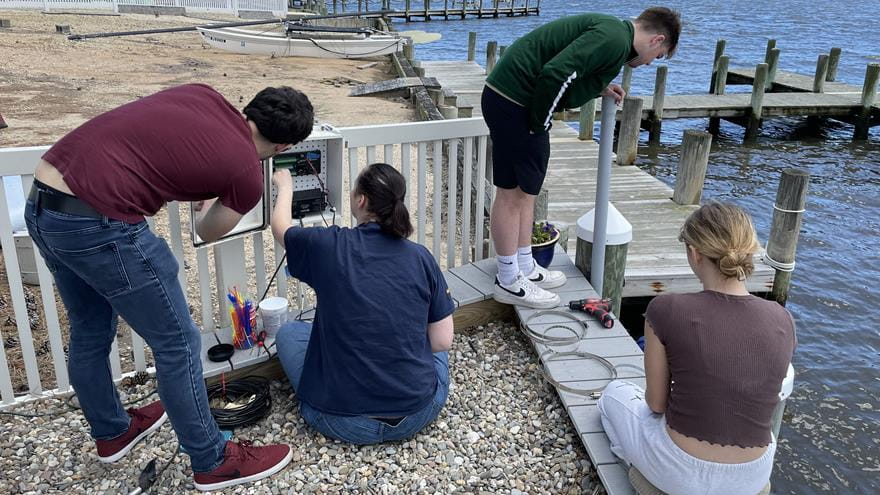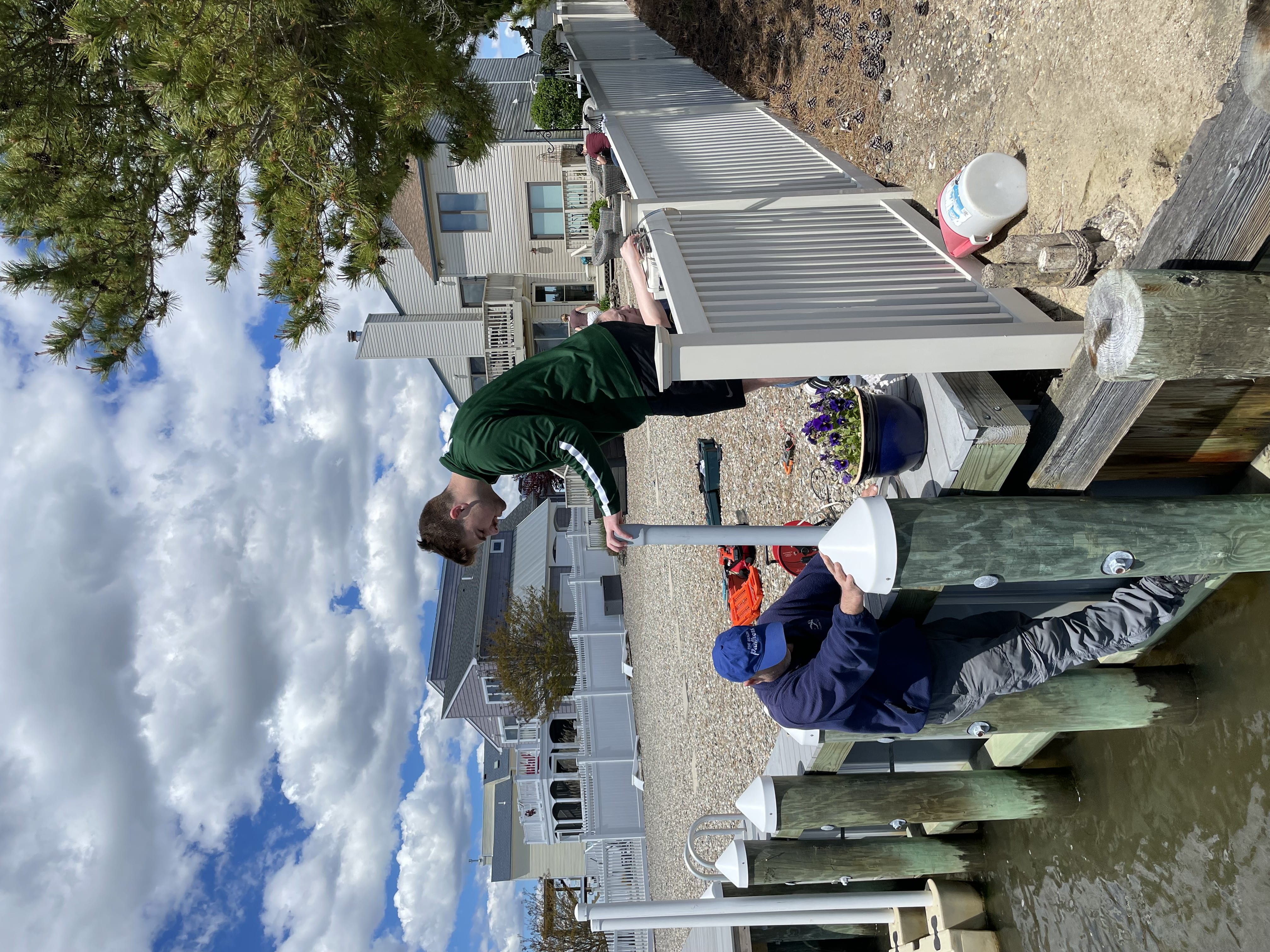Students Tackle Climate at Jersey Shore Town
By: Natalie Kostelni


In the opening scenes of the film Higher Ground: Restorative Science and Sustainability, Carolyn Moseley described the Eastwick neighborhood of Philadelphia as an “environmentally hazardous sandwich.”
Adjacent to Philadelphia International Airport and the Heinz Wildlife Refuge in Southwest Philadelphia, Eastwick sits at the convergence of two creeks — Darby and Cobbs — and at the bottom of a watershed. During torrential downpours, homes can flood with up to eight feet of water.
It’s not the only community prone to flooding caused by more intense storms. The problem is experienced across the region by residents of the Cramer Hill neighborhood in Camden, N.J., and in Stafford, a Jersey Shore community that faces Barnegat Bay.
Franco Montalto, a civil and environmental engineering professor at Drexel, has used all three communities as an extension of his classroom, applying what he teaches to real-world projects for students to get hands-on experience and a deeper understanding of course material. Passionate about taking a project-based approach to teaching, Montalto authored a September 2023 article in Nature titled “How tackling real-world problems transformed my teaching and research: Designing courses on the basis of what really matters to people is a win–win for students and society.”
“I’ve always enjoyed immersing students in discussions about complex societal problems. I’ve found that they really appreciate these opportunities for problem-based learning,” Montalto said in a later interview. “Students wonder: ‘Why are you teaching me this if I’m never going to use it?’ But if I can show them a problem and have them work on it, they do better work and are more interested in learning about a specific tool or concept I might have on the syllabus. Even if they don’t use it in the future, they understand the utility of it.”
In the fall 2023, Montalto returned to Stafford, the New Jersey shore community, as the focus for a course called “Open Channel Flow” in which students were taught a modeling tool called HEC-RAS, which was developed by the U.S. Army Corps of Engineers.
Elizabeth B. Watson, a former professor at Drexel now at Stonybrook University, taught a course in conjunction with Montalto’s on nature-based solutions (NBS) to flooding that can enhance wetlands and nourish local wildlife. Montalto and Watson linked the two classes so that both sets of skills could be applied in the development of solutions to Stafford’s flooding problems.
Those taking Montalto’s fall course picked up where previous Drexel students left off during a class he taught in the spring 2023 term. Both courses immersed students in the development of flood mitigation solutions for Beach Haven West, a community in Stafford prone to flooding.
Students in the spring class installed a tide gauge that collected months of water level data. The fall class used that data as inputs to create computer simulations used to evaluate the effectiveness of different NBS to reduce Stafford’s flood risks.
“We’re modeling scenarios that are actively being debated by local decision-makers and the community,” Montalto said.
Drexel has a long history working with external partners, not only through its co-op employment model, but also in the classroom. Since joining Drexel in 2007, Montalto has collaborated with local and state governments and agencies, nonprofits, advocacy groups among others, to enhance students’ learning experiences.
“I feel that higher education needs to help young people to see themselves not just as individuals, but as members of interdependent groups with common interests that need each other to thrive,” Montalto wrote in Nature. “I don’t know how to teach this other than by plunging students into communities and real-world problems.”

A Move to the Suburbs
When Montalto was 10 years old, his family relocated to Cranford, N.J., from Brooklyn. The move from a dense, multicultural urban environment to a leafy green suburb with more open space left a lasting impact on Montalto.
“In retrospect, it was a huge and formative experience for me,” he said. “I began to understand the tradeoffs between land-use decisions, environmental conditions, and social opportunities. I remember going outside with a ball on my new block and experiencing a completely different reality from the one I had grown up in in Brooklyn. There were more green spaces in which to play, but fewer and less diverse people to play with — a missed opportunity to integrate environmental and social realities.”
This observation led Montalto to initially focus on urban studies in college, though ultimately, he studied civil engineering at the Cooper Union for the Advancement of Science and Art in New York. After graduating, he became a Fulbright scholar in Venice, Italy, where he combined his interests in cities, urban planning, environment and water. His nearly two years of work in Venice culminated in the design and construction of a constructed wetland that, to this day, treats the wastewater generated on one of that city’s historical islands.
After briefly working with the New Jersey Meadowland Commission on efforts to restore degraded urban wetlands in Northern New Jersey, Montalto went to Cornell University where he earned master’s and doctorate degrees in environmental engineering with a minor in city and regional planning.
“Graduate school was a seminal experience because it allowed me to further consider how to integrate my interests in cities, environmental restoration, and culture in my professional future,” he said.
A professor on Montalto’s doctoral committee encouraged him to combine his passion for cities and his engineering skills to tackle projects involving a broad set of interrelated goals. “’Be the specialist who is also the integrator,’” Montalto recalled the professor telling him. The message resonated.
Montalto joined Drexel after working at the Earth Institute at Columbia University, and founding eDesign Dynamics, a design firm based in New York in which he continues to be involved. Working both in academia and in the private sector has enabled him to approach problems from different angles.
“The company is solving problems for specific clients, while through research I can innovate new types of solutions,” he said. “In this way, my research is informed by my private practice and my private practice informs my research. In the process, my students learn not just theory, but how to apply it in the real world.”
Montalto directs the Sustainable Water Resource Engineering (SWRE) Laboratory at Drexel.
Climate Impacting Communities
Montalto began Drexel’s research in Camden in 2010, involving multiple undergraduate and graduate students who were learning hydrologic and hydraulic modeling in the conceptualization of solutions to the chronic flooding problems that plague the city’s Cramer Hill neighborhood.
The classroom research was presented before Camden County Municipal Utilities Authority (CCMUA) officials who ultimately funded a full-time Drexel research scientist to continue the work. The CCMUA leveraged the work to apply for and win $2 million from FEMA to design flood mitigation solutions for Harrison Avenue, with up to $20 million potentially on the table for implementation. At Drexel, one research paper has been published and another has been submitted from the completed work and data collected. Drexel has been involved in four different contracts with Camden.
“Camden is a really exciting example of the work we do,” Montalto said. “Here’s a place where I believe university research helped local leaders to develop real world, funded infrastructure solutions."
Matthew von der Hayden has been Stafford’s township administrator for nearly five years and first met Montalto in early 2023 as the township began to explore how to spend a $5 million grant to restore marshes and mitigate coastal flooding. With Drexel a member of the Consortium for Climate Risk in the Urban Northeast (CCRUN), Montalto and other researchers were already aware of the potential risks of rising sea levels along the Jersey Shore.
That meeting led to Montalto’s spring Drexel class working with the Marine Academy of Technology and Environmental Science (MATES), a local high school that focuses on marine and environmental science in Ocean County as well as Beach Haven West Community Association to set up a transducer in Mill Creek to collect tidal data.
Chris Sherman, a junior who majored in civil engineering and working on a master’s in environmental engineering, took Montalto’s spring and fall course that partnered with Stafford. He also graduated from MATES.
“I actually find project-based learning really refreshing,” he said. “So many engineering courses have been lectures based on concepts. Now that I am getting into my later years of college, I am able to apply that knowledge, and Franco’s courses have been such a great introduction to that. These projects are not just hypothetical, but you are having real-world effect. It’s great to see the results of the engineering I have been learning.”
Alyssa Kemp, a fourth-year student pursuing accelerated bachelor's and master's degrees in environmental engineering, took the fall course as a requirement for her focus on water resources engineering. “Having that real-world application has been so valuable to close that gap between theory and real-world practices,” she said. “That was wonderful.”
Kate Singh grew up knowing she wanted to have a career that involved the environment. She took engineering courses in high school and is a fourth-year environmental engineering major with a concentration in water resources. Singh worked with Montalto before in his lab and other projects and took the fall course to satisfy a requirement.
In prior courses, Singh learned math and equations related to hydraulics and had been interested in modeling. “I could never bridge that gap in knowing where the equations fit into that model when you go out into the field but this allowed me to do just that,” she said. “While it was a little bit of pressure, it was also exciting to know what we did could have a lasting impact on the town.”
Drexel students made a final presentation to Stafford, New Jersey Department of Environmental Protection and other officials in early December. They walked through modeling projections of water flows and animated them to visually demonstrate aid different scenarios.
“I thought the student presentations were excellent,” said von Der Hayden, the township administrator. “When you’re talking about high-level information like that, to have it animated has a lot more impact.”
For von der Hayden, working with Drexel students has given him insight into areas he doesn’t have the expertise to explore and fresh takes on the flooding situation the town faces.
von der Hayden is hopeful the township and Drexel will undertake another project together. They are working to secure a grant from NOAA.
“If we get that grant, we’re absolutely going to be working together again,” he said.